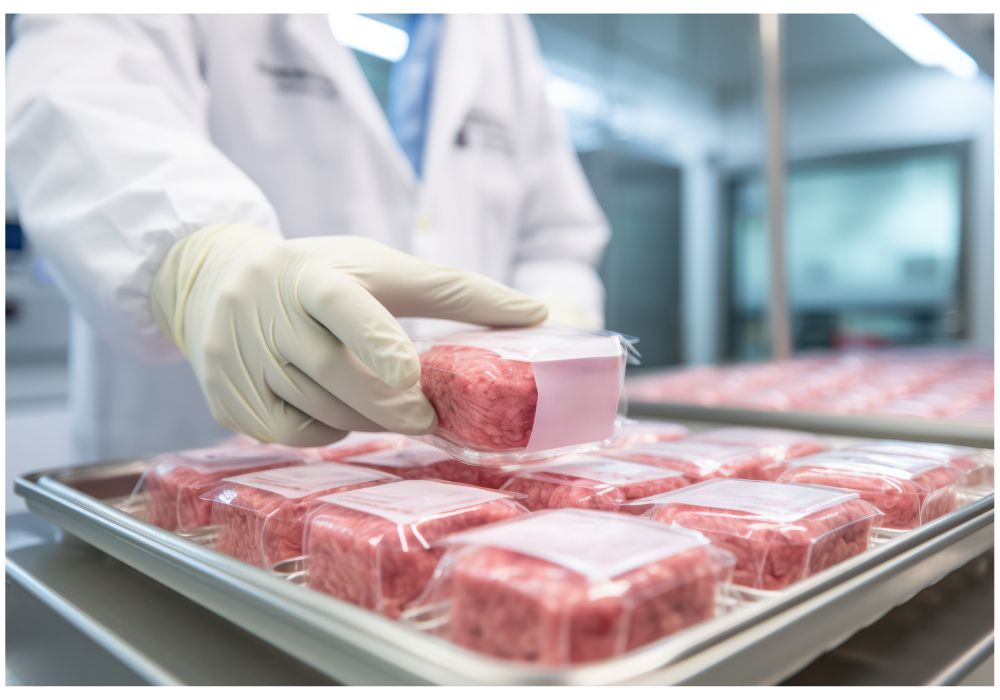Clean, cultivated, lab-grown, cell-cultured or slaughter-free. Whatever the adjectives used to describe meat grown without farming and slaughtering animals, there is no doubt that the innovative product is turning heads in the food sector.
Cell-cultured meat is produced using animal stem cells in large bioreactors that can each replace thousands of animals. The end result is a product that provides a bio-mimicked meat experience, without the eco-harm of farming or the animal-welfare concerns of slaughtering. But as the first cell-cultured meat products received final regulatory approval in the United States earlier this summer and they begin appearing on a handful of menus, they also face competitor contempt, cautious consumers and conflicting media messaging.
Earlier this year, the U.S. Department of Agriculture declared cell-cultured meat produced by two California-based companies, Upside Foods and Good Meat, safe for human consumption. In June, it granted the two companies their first-ever approvals to sell their lab-grown chicken. But just as restaurants in Washington, D.C., and California begin serving up the meat, a study from the University of California, Berkeley, started serving up confusion about the eco-benefits of producing meat without mass animal farming.
U.C. Davis researchers concluded that producing cell-cultured meat could actually be more burdensome to the environment than its traditionally farmed counterpart – a finding that is at odds with the prevailing research. The study states that cell-cultured meat production generates around 25 times the emissions of beef, which produces around 14% of global greenhouse gas emissions. Media outlets such as New Scientist ran with the damning stat. “There’s a big environmental downside to lab-grown meat,” read a San Francisco Chronicle headline. “New study is extremely embarrassing for lab-grown meat,” proclaimed Futurism.
But as some proponents of alternative protein have subsequently pointed out, there are key points about the research that have not been made clear, notably that the study had not yet been peer-reviewed. “So its assumptions and conclusions are subject to change,” Good Food Institute (GFI) says in a statement.
GFI is an international non-profit think tank with a focus on alternative proteins. GFI’s senior vice-president of science and technology, Liz Specht, called out New Scientist for reporting on the non-peer-reviewed environmental impact study, when the research “assumed commercial production of cultivated meat would rely on pharmaceutical-grade media to feed the cells – which food manufacturers won’t need to use.”
Pharmaceutical-grade materials require more intensive methods of purification and around 20 times more energy than food-grade materials (according to a 2010 analysis). They’re also much more costly. “If the cultivated meat industry were to pursue this method of sourcing and purifying media inputs, the costs would likely be too high for the vast majority of products to be competitive with conventional meat,” the GFI statement reads. “As the UC Davis study demonstrates, it also comes at a high environmental cost. So it wouldn’t make economic or environmental sense for cultivated meat companies to take this method forward.”
GFI recommends that media and consumers instead look to peer-reviewed studies, such as one published recently in the International Journal of Life Cycle Assessment that is based on data from more than 15 companies about their manufacturing. That meta-analysis, GFI explains, “found that cultivated meat produced at scale using renewable energy could reduce the carbon footprint by 92%, land use by 90%, and water use by 66% compared to conventional beef production.”
“It’s really kind of a crazy study,” GFI president Bruce Friedrich said on a panel at the Animal and Vegan Advocacy Summit, held in Los Angeles in July. “It’s a bit like saying electric vehicles will never catch on because there is no charging infrastructure, which means there never will be a charging infrastructure. There’s never been innovation which involved taking exactly how it’s done now and making that billions of times larger.”
“Just as we wouldn’t assess the environmental impact of solar panels based on 1980s prototype production methods,” Specht echoes, “we shouldn’t assess cultivated meat’s potential impact using R&D-scale processes.”







